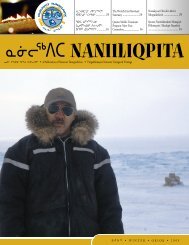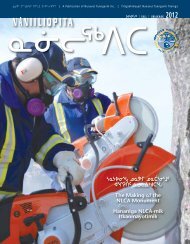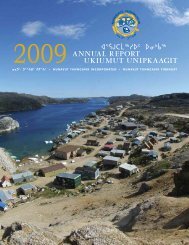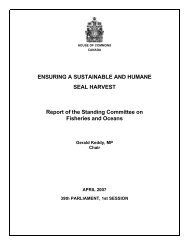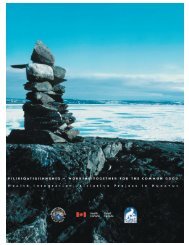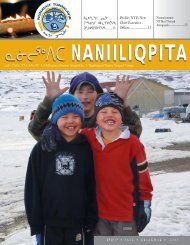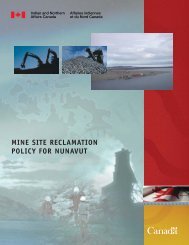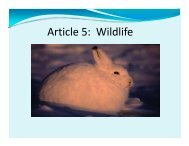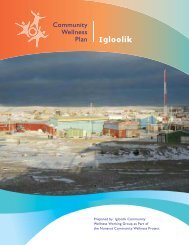áááá á±á á ááá«ááᦠá ááá 2009 - Nunavut Tunngavik Inc.
áááá á±á á ááá«ááᦠá ááá 2009 - Nunavut Tunngavik Inc.
áááá á±á á ááá«ááᦠá ááá 2009 - Nunavut Tunngavik Inc.
You also want an ePaper? Increase the reach of your titles
YUMPU automatically turns print PDFs into web optimized ePapers that Google loves.
Nauligaqvik, on the eastern Hudson coast, is about half way between<br />
Inukjuak and Puvirnituq. This location is significant to the High Arctic relocation<br />
story as the northernmost place in the vicinity from which Inuit families<br />
were recruited for the First Wave in 1953. At the time, my family was living at<br />
Saputiligait, twenty miles north of Nauligaqvik, and it was there that I was<br />
born in 1951.<br />
My parents knew many of people who were relocated.<br />
My late father had been good friends with Jackoosie<br />
Iqalluq, who went north with the Second Wave in<br />
1955. They had shared friendly competition in their<br />
youth, trying to out-do each other in the way young<br />
carefree men tend to do. The Iqalluq family had lived<br />
for some years at Saputiligait.<br />
“I wonder how Jackoosie is?” my father would<br />
ask, to nobody in particular. I never knew the man he<br />
would occasionally think about aloud. It seemed<br />
absolutely impossible for my father to fulfill his longing<br />
to hear from his friend. Those who were relocated<br />
seemed to have been banished to the ends of<br />
the earth.<br />
Separation from the friends and relatives left behind<br />
was seemingly permanent. But the relocated people<br />
had not died, and this made the separation haunting.<br />
They were alive, but now lived unreachably far away.<br />
There was no radio, and mail in the early years depended<br />
on one annual ship-time for all locations<br />
throughout the Arctic. Isolation was almost impossible<br />
to breach.<br />
By around the age of ten, I remember my father’s<br />
joy at finally receiving some letters from his friend. I<br />
can still see the return address, written in wobbly print<br />
on the top left corner, “Eskimo Jackoosie, Resolute Bay,<br />
N.W.T.” By then, we were students in a federal day<br />
school. I looked up the place on a map, and thought,<br />
“My goodness! They have been banished to the ends of<br />
the earth!”<br />
Jackoosie Iqalluq moved back to Inukjuak in 1977,<br />
and I got to know him well. He told me stories from<br />
the years prior to the relocation. His friendship of<br />
decades earlier with my father was shifted to me and<br />
my family in a most natural and “meant-to-be” sort of<br />
way. He made me a pana (snowknife) and iqqatautiit<br />
(seal retrieval hooks). He made ulus for my wife and<br />
daughters. He was like a kind uncle to all of us.<br />
There’s a lake near Saputiligait, called Iqalluup<br />
Tasinga (Iqalluq’s Lake). It had been a favoured fishing<br />
spot of Iqalluq, Jackoosie’s father. Jackoosie told me its<br />
original name was Kakiattuq. The knowledge of that<br />
lake’s true name had been exiled in the High Arctic for<br />
over twenty years with Jackoosie. Despite the truth<br />
being revealed, the lake continues to be called Iqalluq’s<br />
Lake; a name which cannot be shaken off.<br />
Jackoosie Iqalluq died in 2007 in Inukjuak, having<br />
served as one of the “human flagpoles” for Canada’s<br />
sovereignty in the High Arctic. He had served his country<br />
just by being there.<br />
Fast-forward to 1988. I was First Vice-President of<br />
Makivik Corporation, with primary responsibility for<br />
political affairs. Many of the original relocatees had by<br />
then moved back to Inukjuak. The relocation, with all<br />
of its festering injustices and backlog of long-suppressed<br />
resentments, had percolated among its veterans<br />
for more than three decades. The story was ripe<br />
for telling, and to be taken to the political forum. It<br />
was time to seek justice.<br />
Makivik took up the fight, and spearheaded negotiations<br />
with the federal government, which lasted<br />
nine years. The Inuit sought remedies for arbitrary<br />
treatment, deliberate deception, and broken promises.<br />
One of their main objectives was the pursuit of a<br />
formal apology from the Government of Canada,<br />
an expression of remorse for the way relocatees had<br />
been treated.<br />
The government consistently resisted apologizing<br />
for anything. Eventually, the Government did agree to<br />
a Trust Fund to compensate the people for disrupted<br />
lives and ruptured connections to relatives and places<br />
of origin. However, Elders among the relocatees had<br />
most desired to hear the government say, “I’m sorry.<br />
We treated you wrongly.” This is an unresolved issue,<br />
and must be taken up again. <br />
The memory of<br />
these pioneers lives on!<br />
N • o6W b | N A N I I LIQP I TA 3 1




